Noontime Namaste
January 3, 2013
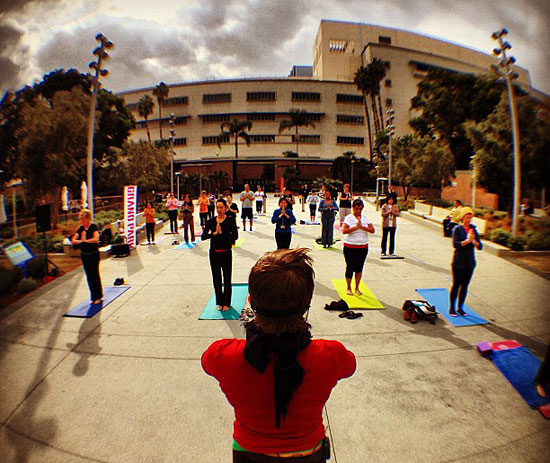
Christel Joy Johnson's yoga class has become one of Grand Park's most popular programs. Photo/Javier Guillen
Christel Joy Johnson has a resolution for all you desk-bound downtowners: Come see her at lunchtime—and breathe.
Since November, Johnson has been leading one of the most popular public programs at Downtown Los Angeles’ new Grand Park, a free lunch-hour yoga class. The free 45-minute sessions have been drawing passersby, office workers and downtown hipsters, who’ve gathered by the score in a performance space between Grand Avenue and Hill Street for the gentle midday workouts, even in inclement winter weather.
“We thought we’d get maybe ten people,” Johnson says laughing. “The first time we held the class, 50 people showed up.”
Since then, she says, the classes—at 12:15 p.m. on Wednesdays and Fridays—have averaged 30 to 40 students.
“It’s everybody from county workers on their lunch break and Music Center employees to people who come by bus or walk over from apartments and bring their yoga mats with them,” she says.
“It’s getting so I’m starting to see some of the same faces. There are two girls in the front who live downtown and have been there for every session. I imagine with New Year’s resolutions we’ll get even bigger when we start up again on January 9.”
The Wisconsin-born Johnson, 39, didn’t set out to become the unofficial yogi of a major metropolitan civic center. Like so many in L.A.’s service sector, she came here to act.
Arriving in her mid-20s with a degree in theater arts from San Francisco State, she says, she gravitated toward small ensembles; she is currently a member of the local theater group Ghost Road Company. Work as a production assistant on films and at the Music Center helped underwrite her stage career, she says, “but theater doesn’t pay a lot, so I had to do other jobs to pay the bills.”
One of those other jobs was yoga, which she had taken up while she was a student to help mitigate the lingering effects of an assortment of old back injuries.
“About six years ago,” she says, “I became really serious about it, and in 2009, I did a 3-month teacher training at the YogaWorks in Larchmont Village, where I had taken some classes.”
At first, she says, the intensive training was a personal challenge and a means of coping with a series of illnesses in her immediate family. Over time, however, she found she enjoyed the challenge and the personal contact.
She’s taught in fitness centers, community classes and for private clients. But for all her skill at saluting the sun and assuming the “downward dog” position, it was her theater network that led to the Grand Park gig. From the outset, park programmers had talked about yoga classes as a way to entice the brown-bag lunch crowd away from their desks and into the fresh air.
“I’d been a part-time production assistant at the Music Center for eight years,” she says, “and the Music Center does the programming for Grand Park. When they decided they wanted to do yoga classes, and that they wanted to produce something themselves rather than team up with a studio, someone mentioned that I taught yoga and they approached me.” Though the classes are open and free to the public, the Music Center pays Johnson for her time.
“I love it,” she says simply. “You’re outside. You have the sky and the trees. Hummingbirds fly around the group as we do our class. And it’s really cute—people in business suits at the Starbucks will often take in our energy as they sit there watching. One day, a group of ladies in very nice clothes was just quietly doing yoga with us in their chairs.”
About a third of the group is male, she says, and ages range from twentysomething to seventysomething. Most, though, are middle-aged beginners who appreciate her ability to help them tailor the positions to build flexibility.
“As someone who loves yoga and thinks it’s a beautiful thing for the community, I hope the program grows,” Johnson says, noting the success of other outdoor programs such as the free daily yoga in Hollywood’s Runyon Canyon Park.
For now, she and her students are just glad that the lunch-hour yoga has been extended for another quarter. “It’s probably not going to lead to acting jobs,” she says, laughing. “But that’s not why I do it.”
Posted 1/3/13
Lights out for L.A. Christmas trees
January 3, 2013
The end of the holidays can be such a grind.
Particularly for the hundreds of thousands of Los Angeles County Christmas trees being chopped up, ground down or otherwise looking for a new line of work in the days and weeks ahead.
Yes, it’s the most resolution-making time of the year, and prominent among all the do-good messaging is the mantra to go green by recycling that tree. The city of L.A. is touting the fire safety benefits along with the environmental upside, while the county is promoting convenient curbside pickup to have ol’ tannenbaum transformed into “compost, mulch, or ground cover.” But the reality of L.A. Christmas trees’ final chapter is a little more complicated than it might seem, with different approaches in place in the county’s various communities and plenty of ground up trees ending up covering a variety of sins in local landfills as “alternative daily cover.”
Sure, some of these former glitter kings of the living room go on to a bucolic-sounding afterlife. The 100,000 or so trees picked up by the city of Los Angeles’ Bureau of Sanitation, for example, are made into mulch and used as ground cover here or sent to farms in Kern and Ventura counties. (Residents can pick up a free bag year-round at any of the locations on this city map.) Santa Monica’s Christmas trees—some 25 tons of them—are chipped at local parks and pressed into landscaping duty around town; the 2011 crop is now serving as mulch at the Santa Monica Airport.
In Avalon, teams of fourth-graders, guided by the Catalina Island Conservancy, recycle several hundred trees each year by placing them in gullies where they provide natural erosion control. First, the kids strip off all the tinsel and other “unnatural parts” like ornaments or tree stands, then work together to move the trees to gullies where they’ll hold soil in place and make it possible for new plants to grow.
Other Christmas trees—some 386,235 last year—are off on a whole different kind of sleigh ride. These trees, from unincorporated communities and about 80 cities throughout the county, are picked up by trash haulers and trucked to local landfills, where they’re ground up to become “alternative daily cover”—the stuff they put over the trash every night to keep things tidy and reduce odors. It may not be the most glamorous job on the Christmas tree lot, but somebody’s gotta do it—and county officials say it’s a beneficial form of recycling permitted under state law.
Under the program, trash haulers from participating cities drop off the Christmas trees at the landfills free of charge.
“I personally believe alternative daily cover is a great market for this material. It’s a pretty great use in these urban markets, rather than hauling it away” to be converted into compost at a faraway facility, says Nick Morell, recycling coordinator for the county Sanitation Districts. He said the ground-up Christmas trees take the place of dirt that would otherwise have to be trucked in and used as cover.
The recycled Christmas tree cover also lessens smells, prevents fires, reduces dust and “keeps critters away,” says Pat Proano, assistant deputy director of the environmental programs division for the county’s Department of Public Works.
While composting would be a “preferred option” for retired Christmas trees, Proano says, there’s not enough of a local agricultural market for all that would be produced in a county the size of Los Angeles. “We’re not farmers,” he says. “The quantities are huge.”
Still, Proano says, this year’s planned closure of the county’s Puente Hills landfill, the nation’s largest, will require some rethinking of how the county recycles its Christmas trees before the next holiday season rolls around.
As things stand now, Proano says, most residents are “probably not” aware of where their Noble fir or Scotch pine will end up after their trash hauler picks it up curbside.
“They’re just probably glad to have the service,” he says. (To check out what’s going on in your community, click here for a list of contact numbers and websites. Please note that different cities have different requirements—Los Angeles asks that residents cut their trees into pieces small enough to fit into their green yard waste bins, for instance, whereas Santa Monica requests that trees be kept out of the bin and dropped off at parks. No matter when you live, tinsel must be removed along with decorations and tree stands before pick-up, and flocked trees are generally frowned upon.)
Getting the inside story of what actually happens to the family fir after it’s left at the curb can be a bit traumatic, as a group of Long Beach students learned last year.
“They were totally disillusioned,” recalls Lisa Harris, the city’s top recycling specialist. She says the Rogers Middle School students had wanted to research the happy hereafter of Christmas trees. “They were hoping the trees were going to be turned into a buttery compost”—not pressed into service for “alternative beneficial use” in landfills.
However or wherever a real Christmas tree meets its end, it’s a good environmental outcome, in the view of Rick Dungey, public relations manager for the National Christmas Tree Association.
“There are so many things you can do with it because it’s a plant,” he says. (For instance, discarded Christmas trees in Riverside County are being placed in Lake Elsinore to create fish habitat.)
Dungey’s no fan of the faux tree, which he terms “a giant green toilet brush” that’s destined for a non-biodegradable future in a landfill someday.
His organization estimates that 30.8 million real Christmas trees were sold in the United States in 2011, along with 9.5 million artificial trees. They don’t do regional breakdowns, but that translates roughly to one real tree for every ten residents.
Already looking ahead to next year? Sunset magazine’s take on the pros and cons of real and artificial trees is here. And—just as reusable bags have offered a way around the eternal paper vs. plastic debate at the grocery checkout—there could be a third holiday decorating option to consider come next December: rented live Christmas trees, for those who can’t bear to send their evergreen to the great beyond.
Posted 1/3/13




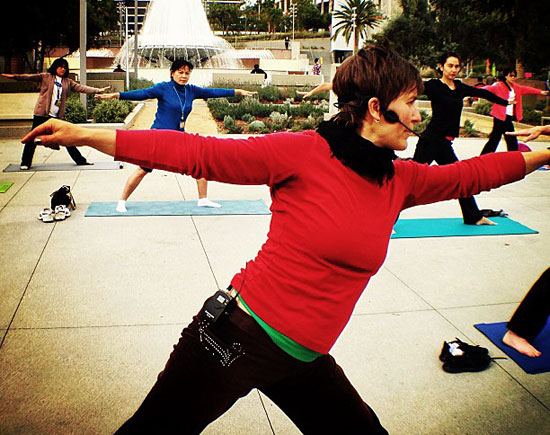
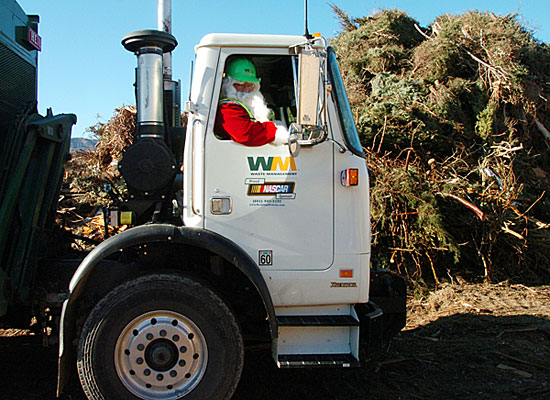
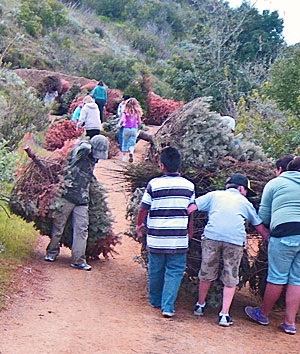
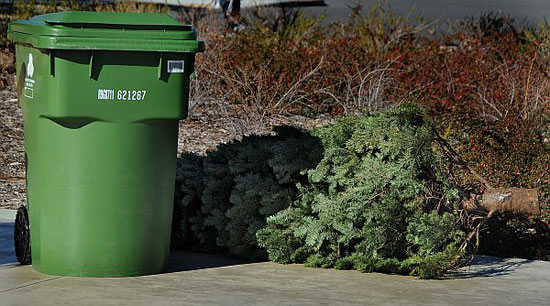





 Check for the latest closure information
Check for the latest closure information








